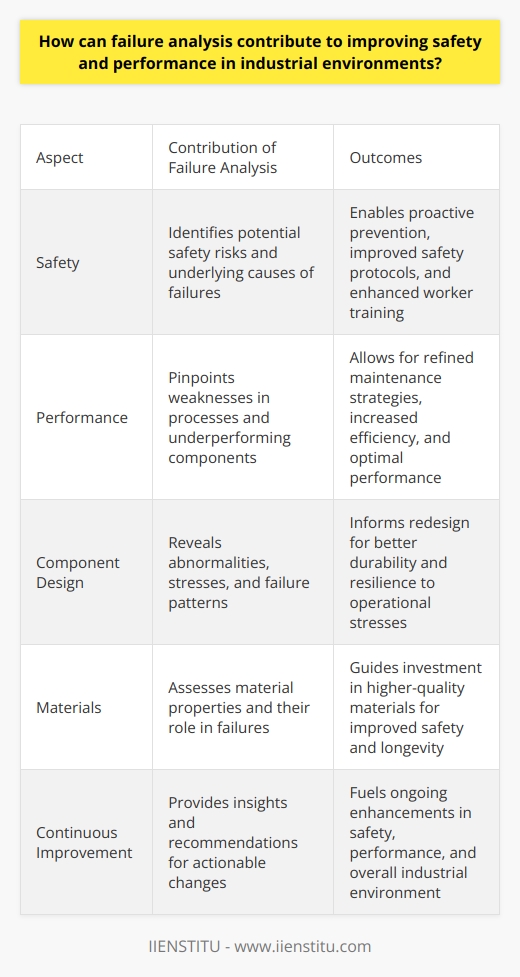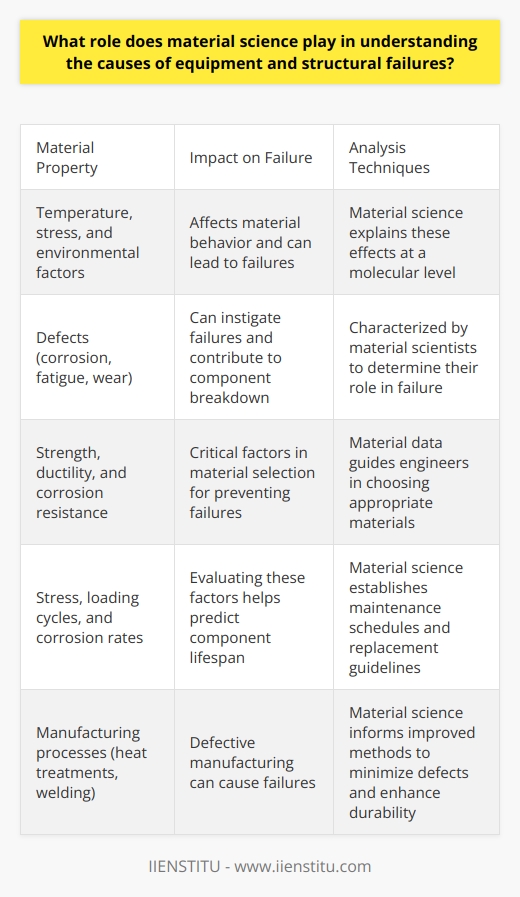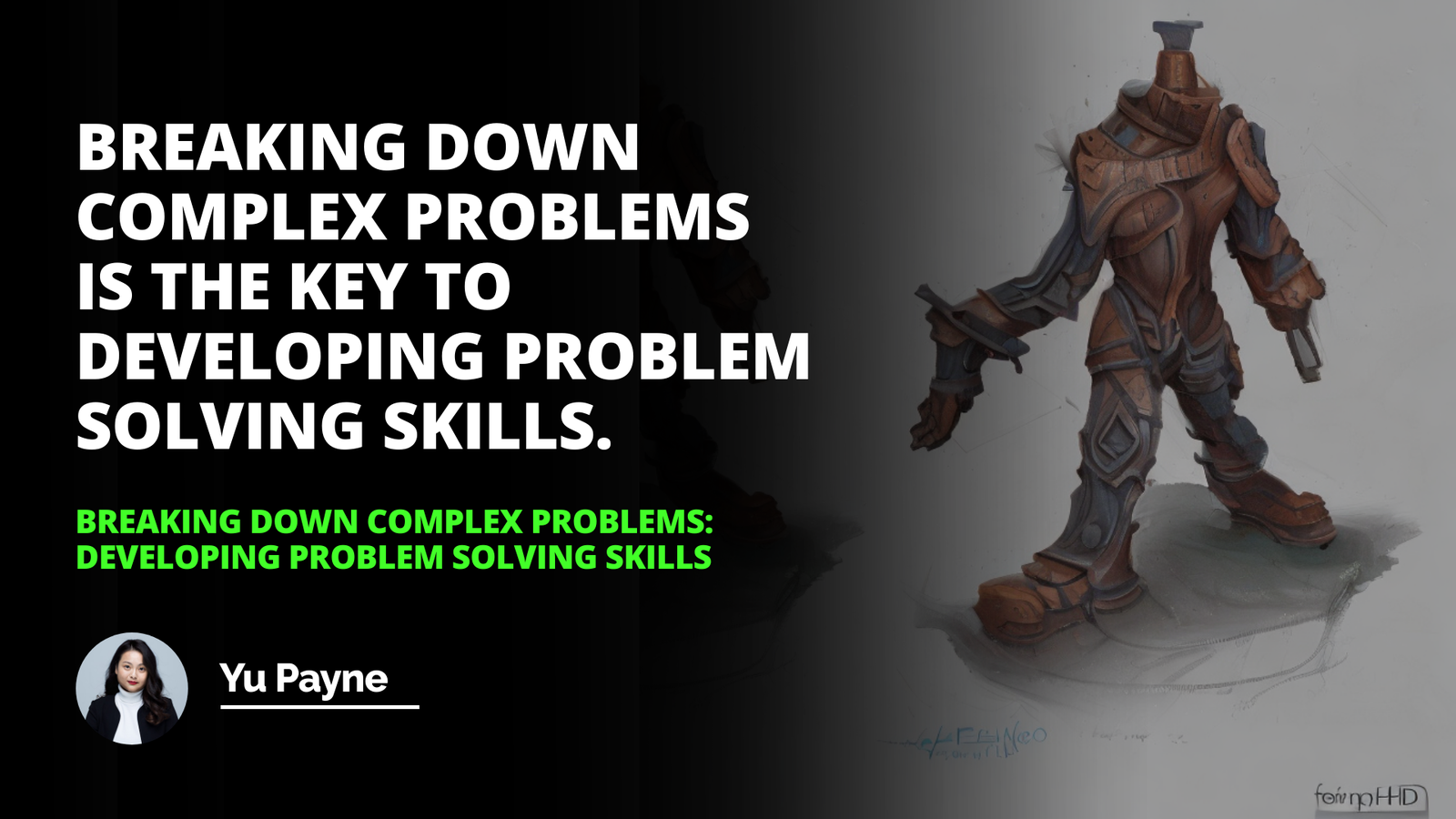
As an engineer with over a decade of experience in various industries, I've come to appreciate the critical role that failure analysis plays in ensuring the safety, reliability, and efficiency of the products and systems we rely on every day. From investigating the collapse of a bridge to diagnosing the failure of a tiny electronic component, the process of failure analysis is like solving a complex puzzle - one that requires a keen eye for detail, a systematic approach, and a relentless pursuit of the truth.
In this blog post, I'll take you on a journey through the fascinating world of failure analysis, sharing my personal experiences and insights along the way. We'll explore the fundamentals of this discipline, its significance across different industries, and the exciting future trends that are shaping its evolution. So buckle up and get ready for an adventure into the heart of what makes things break!
The ABCs of Failure Analysis
At its core, failure analysis is all about answering one question: "Why did this fail?" But as any seasoned failure analyst will tell you, getting to the bottom of a failure is rarely a straightforward process. It requires a deep understanding of the underlying failure mechanisms, a systematic approach to data collection and analysis, and a bit of good old-fashioned detective work.
Understanding Failure Mechanisms
The first step in any failure analysis is to identify the specific mechanism(s) that led to the failure. Was it fatigue? Corrosion? Overload? Each mechanism leaves behind its own unique set of clues, and it's up to the failure analyst to piece them together.
I remember one particularly challenging case involving a fractured aircraft component. Initial inspections suggested fatigue as the culprit, but something didn't quite add up. After hours of pouring over microscopic images and conducting material tests, we discovered that the real cause was a rare phenomenon called stress corrosion cracking. It was a reminder that even the most experienced analysts can be surprised by the complexities of failure mechanisms.
The Failure Analysis Process
Once the failure mechanism(s) have been identified, the real work begins. The failure analysis process typically involves the following steps:
Collecting data: This is where the failure analyst puts on their detective hat and starts gathering evidence. Visual inspections, non-destructive testing, and laboratory analyses are just a few of the tools in their arsenal.
Analyzing the data: With the data in hand, it's time to start connecting the dots. This often involves a lot of head-scratching, number-crunching, and consultation with experts from various fields.
Determining the root cause: The ultimate goal of failure analysis is to identify the root cause of the failure. Was it a design flaw? A manufacturing defect? Improper maintenance? The answer is often a combination of factors, and it's up to the failure analyst to untangle the web of causality.
Recommending solutions: Finally, the failure analyst must use their findings to develop practical recommendations for preventing similar failures in the future. This could involve changes to design, materials, manufacturing processes, or maintenance procedures.
Throughout this process, communication is key. As a failure analyst, I've learned that it's not enough to simply uncover the truth - you also have to be able to explain it in a way that non-experts can understand and act upon. This often involves translating complex technical jargon into plain language and using visuals like graphs, charts, and diagrams to convey key concepts.
Why Failure Analysis Matters
Failure analysis is not just an academic exercise - it has real-world consequences that impact businesses, consumers, and society as a whole. Here are just a few of the reasons why failure analysis is so important:
Improving Product Quality and Safety
One of the primary goals of failure analysis is to identify and eliminate potential hazards before they cause harm. By understanding the root causes of past failures, manufacturers can design safer, more reliable products that meet the needs of their customers.
I've seen firsthand how failure analysis can drive significant improvements in product quality and safety. In one case, our team was called in to investigate a series of failures in a consumer appliance. Through careful analysis, we discovered a design flaw that had gone unnoticed during the product development phase. By working with the manufacturer to implement a simple design change, we were able to eliminate the problem and prevent countless potential injuries.
Optimizing Maintenance and Reliability
Failure analysis also plays a critical role in optimizing maintenance and reliability programs. By understanding the failure modes and mechanisms of critical assets, organizations can develop targeted maintenance strategies that minimize downtime and extend the useful life of their equipment.
In my experience, one of the most effective ways to optimize maintenance is through the use of predictive analytics. By analyzing data from sensors, inspections, and other sources, failure analysts can identify potential problems before they occur and schedule maintenance activities accordingly. This not only reduces the risk of unexpected failures but also helps organizations make the most of their limited maintenance resources.
Driving Innovation and Continuous Improvement
Perhaps most importantly, failure analysis is a key driver of innovation and continuous improvement. By constantly pushing the boundaries of our understanding of failure mechanisms and root causes, failure analysts help to identify new opportunities for optimization and growth.
I've been fortunate to work on several projects where failure analysis has led to significant breakthroughs in materials science, manufacturing processes, and design methodologies. In one case, our team's investigation of a failed aerospace component led to the development of a new surface treatment process that dramatically improved the fatigue life of critical parts. It was a reminder that even the most challenging failures can be opportunities for learning and advancement.
The Future of Failure Analysis
As technology continues to evolve at a rapid pace, so too does the field of failure analysis. Here are a few of the exciting trends and developments that I see shaping the future of this discipline:
Big Data and Machine Learning
One of the biggest challenges in failure analysis is dealing with the sheer volume and complexity of data generated by modern systems and devices. From sensor readings to maintenance records to customer feedback, there's simply too much information for any one person (or even team) to process manually.
That's where big data and machine learning come in. By leveraging advanced analytics tools and algorithms, failure analysts can quickly identify patterns and anomalies that might otherwise go unnoticed. This not only speeds up the failure analysis process but also enables more accurate and reliable predictions of future failures.
Artificial Intelligence and Predictive Maintenance
Another area where I see significant potential for failure analysis is in the realm of artificial intelligence (AI) and predictive maintenance. By combining machine learning algorithms with physics-based models and expert knowledge, organizations can develop highly accurate predictive models that can detect potential failures days or even weeks in advance.
I've already seen some impressive examples of this in action. In one case, a manufacturing company was able to reduce unplanned downtime by over 50% by implementing an AI-powered predictive maintenance system. The system continuously monitored key performance indicators and used machine learning algorithms to identify potential failures before they occurred, enabling the company to schedule maintenance activities during planned downtime and avoid costly disruptions to production.
Augmented Reality and Remote Collaboration
Finally, I believe that augmented reality (AR) and remote collaboration tools will play an increasingly important role in failure analysis in the years to come. With AR, failure analysts can overlay digital information onto physical objects, making it easier to visualize and diagnose complex failures. And with remote collaboration tools, experts from around the world can work together in real-time to solve even the most challenging problems.
I've already started experimenting with these technologies in my own work, and the results have been promising. In one recent project, I was able to use AR to guide a technician through a complex disassembly process, highlighting key components and potential failure points along the way. It was a powerful reminder of how technology can enhance and extend the capabilities of failure analysts, even in the most challenging environments.
Conclusion
Failure analysis is a fascinating and constantly evolving field that plays a critical role in ensuring the safety, reliability, and performance of the products and systems we depend on every day. By combining rigorous scientific methods with creative problem-solving and cutting-edge technologies, failure analysts are able to uncover the root causes of even the most complex and challenging failures.
But failure analysis is more than just a technical discipline - it's a mindset and a way of thinking that emphasizes continuous learning, collaboration, and improvement. As failure analysts, we must be willing to challenge our assumptions, think outside the box, and always be open to new ideas and perspectives.
As I look to the future of failure analysis, I'm excited by the possibilities that lie ahead. From big data and machine learning to augmented reality and remote collaboration, there are countless opportunities to push the boundaries of what's possible and drive meaningful improvements in product quality, safety, and performance.
But no matter how much technology evolves, one thing will always remain constant: the need for skilled, dedicated failure analysts who are passionate about uncovering the truth and making a difference in the world. And that's a challenge that I'm more than ready to take on.
Frequently Asked Questions
What are the key steps in a comprehensive failure analysis process?
Understanding Failure Analysis
Failure analysis is a critical field. It involves dissecting unexpected or unplanned events within industrial, mechanical, or electronic systems. The core aim is finding the causes. Consequently, mitigating future risk. This process is methodical. It prevents recurrence of similar failures.
Identify the Failure
First, one must acknowledge the failure. A clear understanding is essential. Know the symptoms. Look at the affected components. Detail these observations carefully.
Assemble a Team
Team formation follows. Experts from various disciplines come together. Each member contributes unique knowledge. Diversity in expertise matters. It ensures thorough analysis.
Collect Data
Data gathering comes next. This step involves rigorous detail. One must acquire information on the failure event. Environmental conditions are crucial too. Operational data prior to failure provides insight.
Visual Examination
Perform a visual inspection. Assess the damage. Note discoloration or deformation. Visual clues often hint at underlying issues.
Non-Destructive Testing
Use non-destructive methods. These reveal hidden flaws. X-ray or ultrasound might apply. They detect internal anomalies. All while preserving evidence.
Destructive Testing
Sometimes, components must dismantle. This step should be careful. It further examines material properties. Fracture surfaces and corrosion patterns yield clues.
Analyze Findings
Critically look at test results. Compare these to standards. Understand material properties. Cumulative evidence guides the investigator.
Determine Root Cause
Pinpoint the primary cause. This step can be complex. Often, multiple factors contribute. Causation links come forth from meticulous study.
Report Generation
A detailed report comes last. Include all evidence here. Discuss methodologies and conclusions. This document serves as a blueprint for improvements.
Implement Corrective Actions
Finally, propose solutions. Apply lessons learned. Change design or material. Update processes or training. Prevention becomes the ultimate goal.

How can failure analysis contribute to improving safety and performance in industrial environments?
Understanding Failure Analysis
Failure analysis stands as a pivotal process. It scrutinizes why components failed. By doing so, it reveals underlying problems. These problems often relate to safety and performance. The goal is clear. Learn from past failures to improve future outcomes. In industrial environments, this is crucial.
The Role of Failure Analysis
Failure analysis aids in preventing recurring failures. It allows for a systematic examination. Industry can uncover failure root causes. Engineers and technicians gather failed components. They analyze these components thoroughly. Microscopic examination often occurs. Material properties get assessed. This reveals abnormalities or stresses.
Failure patterns indicate potential safety risks. Such risks warrant immediate attention. Resolving them enhances safety. It also boosts performance. Implementing changes reduces downtime. It also minimizes the risk for catastrophic events.
Safety and performance go hand-in-hand. Improved safety results in more reliable operations. Reliable operations mean better performance.
Boosting Safety Through Failure Analysis
Identifying failure causes is vital. It informs safety protocols. Changes to these protocols can follow. Worker training may improve as a result. Better trained workers commit fewer errors. Safety measures then align with actual risks. Prevention thus happens proactively, not reactively.
Changes to design or materials may emerge. These changes target better resilience. They account for operational stresses. The changes ensure safer environments. They also enhance equipment longevity.
Routine failure analysis can establish new guidelines. Operational limits become clearer. Workflows become safer. Safe workflows translate to improved performance.
Enhancing Performance with Insights
Performance optimization relies on failure analysis. Downtimes from failures hinder productivity. Analysis pinpoints weaknesses in processes. It identifies underperforming components.
Maintenance strategies can be refined. Predictive maintenance can be employed. This approach fixes issues before they escalate. Efficiency increases. Operations run smoother. Smooth operations sustain optimal performance.
- Training improves.
- Processes get streamlined.
- Equipment reliability increases.
Each aspect benefits from failure analysis insights.
Implementing Failure Analysis Outputs
Putting analysis findings into practice matters. Recommendations turn into actions. These actions can include:
- Redesigning components for better durability.
- Updating operating procedures.
- Improving maintenance schedules.
- Investing in higher-quality materials.
Results materialize over time. Safety incidents may decrease. Production rates can climb. Quality often improves. The industrial environment becomes more robust.
Conclusion
Failure analysis is an essential tool. It fuels continuous improvement. Safety and performance depend on it. Each failure teaches a lesson. These lessons shape a safer, more capable industry. They help build an environment where progress thrives. This is the true value of failure analysis in industry.

What role does material science play in understanding the causes of equipment and structural failures?
Material Science in Failure Analysis
Material science plays a pivotal role in failure analysis. It provides crucial insights into the causes of equipment and structural breakdowns. Structural integrity is fundamental to safety and reliability. Therefore, understanding material properties becomes essential.
Comprehending Material Behavior
Materials behave uniquely under different conditions. Engineers must know these behaviors to predict failures. Temperature, stress, and environmental factors all affect materials. Material science explains these effects at a molecular level.
Forensic Investigation of Failures
When failures occur, forensic material scientists step in. They perform detailed material assessments. These often reveal the root causes of failures. Techniques like scanning electron microscopy and spectroscopy become vital tools.
Characterizing Material Defects
Defects in materials can instigate failures. Corrosion, fatigue, and wear are common culprits. Material scientists characterize these defects. They determine how defects contribute to failure.
Improving Material Selection
Material selection is critical for preventing failures. Engineers use material data to choose appropriately. They consider strength, ductility, and corrosion resistance. Material science guides this selection process.
Life Prediction of Structural Components
Material science helps predict component lifespan. It evaluates stress, loading cycles, and corrosion rates. This information establishes maintenance schedules. It also guides engineers when to replace parts.
Enhancing Manufacturing Processes
Defective manufacturing can cause failures. Material science informs improved manufacturing methods. These include better heat treatments and welding techniques. These processes minimize defects, enhancing durability.
Advancing Materials for Extreme Conditions
Engineering for extreme environments is challenging. New materials sometimes must be developed. Custom alloys or composites might be needed. Material science leads these advancements with innovative research.
In conclusion, material science remains integral to understanding equipment and structural failures. It underpins efforts to predict, prevent, and address such problems. Its application spans from forensic investigation to the development of better materials and improved manufacturing processes. Without it, engineering and safety standards could not evolve to meet the demands of modern infrastructures and technologies.



